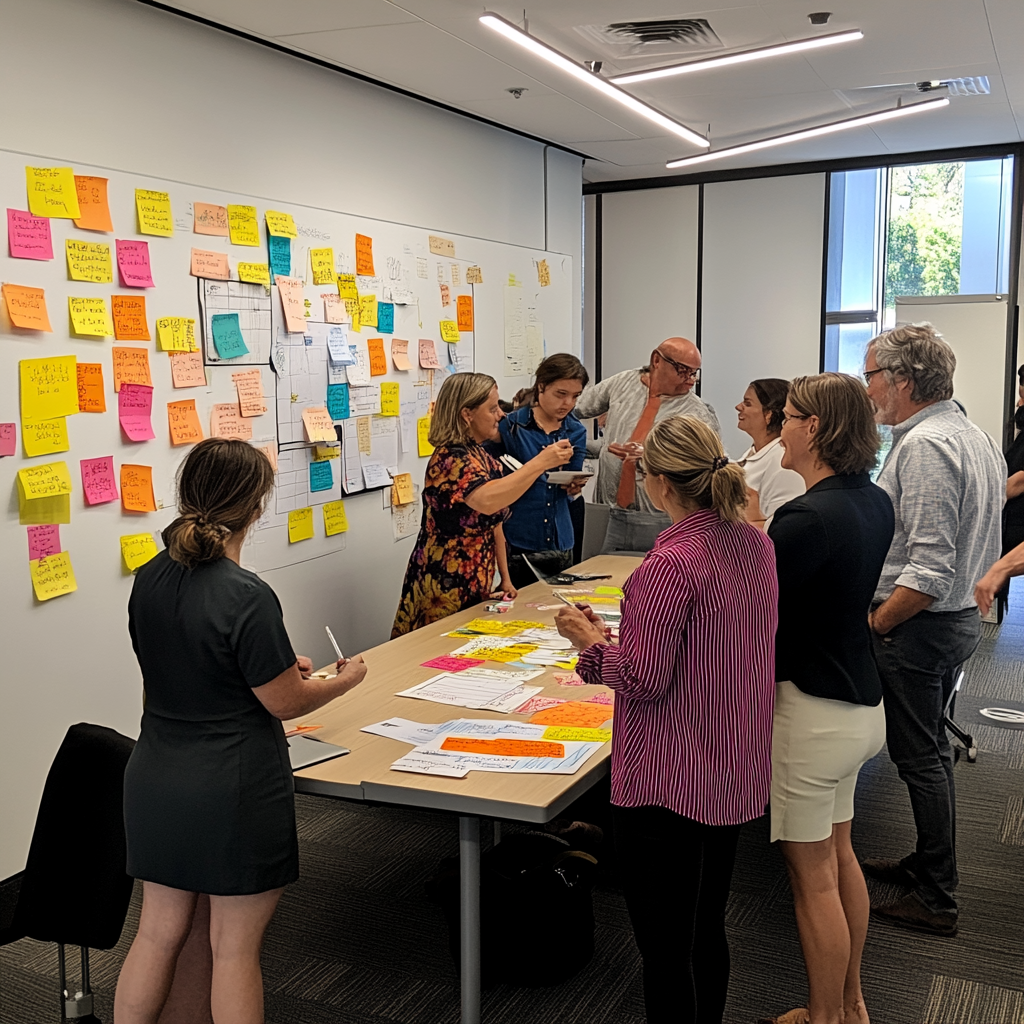Table of Contents |

Community organizing in public and community health involves mobilizing individuals and groups to address health issues and improve health outcomes within their communities. To do this, the community must be a strong community. Recall from earlier in the course that a strong community has some key characteristics, including a shared identity as well as values, beliefs, and goals that foster a sense of belonging and unity. There is also a high level of cohesion, meaning that members feel connected to one another and are willing to support each other. This includes strong interpersonal relationships and a sense of trust.
Community members also actively participate in organized community activities and decision-making processes. This engagement helps ensure that the community’s needs and interests are met. Strong communities have identifiable leaders at all levels of the community, informal and formal, who guide and inspire the community activities and groups. These leaders help organize efforts, mediate conflicts, and represent the community’s interests. In a strong community, there are robust support systems in place, such as social services, volunteer networks, and community organizations, which help members in times of need. Finally, a strong community can adapt to changes and challenges, demonstrating resilience in the face of adversity.
Community organizing for public health purposes targets social determinants of health (SDOH), such as housing, education, and access to health care, which significantly impact health outcomes. This emphasizes empowering community members to take an active role in identifying problems and developing solutions. This participatory approach improves the likelihood that community members will buy into the solutions and ensures the resulting interventions are relevant and sustainable. Effective community organizing involves collaboration between health professionals and community members. This partnership leverages the expertise of health professionals and the lived experience of community members. Not all community organizing will have collaboration with health professionals; these efforts can still be very effective and successful.
One goal of community organizing is to support long-term community empowerment and advocacy to change structures and systems that perpetuate inequity (García et al., 2020). Community organizers often work toward policy changes that address systemic issues contributing to health disparities. This can include advocating for issues like better health care services, improved living conditions, and equitable resource distribution. One way to directly accomplish advocacy and policy change is by directly engaging residents most impacted by social injustice, with the aim of building and sustaining community power that leads to change (García et al., 2020). By fostering relationships and networks within the community, organizing efforts can enhance social support and collective efficacy, which are crucial for moving people to action, creating social change, and long-term health improvements.
IN CONTEXT
Community Organizing in Healthville
A community organizer is someone who works to bring people together to address common issues and improve their community. They help identify issues, build relationships, mobilize people, advocate for change, and help community leaders develop leadership skills so they can take on active roles in organizing community efforts. Community organizers can be formal and paid professionals from outside the community or informal and identified as community members leading the effort to address community issues.
In the town of Healthville, socioeconomic disparities have led to significant health inequities among its residents. The community organizer, Alex, is tasked with addressing these social determinants to improve overall health outcomes. Working with community leaders, Alex begins by conducting a thorough needs assessment to identify the key issues affecting the community’s health. Through surveys and community meetings, Alex discovers that the lack of access to nutritious food, safe housing, and reliable transportation are major barriers to health. Alex partners with local farms to create a community-supported agriculture (CSA) program, providing fresh produce to families at reduced costs. In collaboration with the city council, Alex helps secure funding for the renovation of dilapidated housing and the construction of new, affordable homes. Alex works with the local transit authority to establish a subsidized transportation program for medical appointments and grocery shopping for those without personal vehicles. After implementing these initiatives, Healthville sees a marked improvement in health indicators. Alex’s efforts demonstrate the importance of addressing broader social factors, like income inequality or social exclusion, which lead to or influence health and development outcomes (Community Tool Box, 2014b).
Effective community organizing will include these general components.
| Component | Description |
|---|---|
| Understanding the community | The first step is learning what the community and its residents are like and what is important to the residents. |
| Articulating issues | A crucial part of community organizing is being very clear about what the issues are, what people find important, and what they feel should be done about it. This happens early in the process through assessments that result in specific public health issues. |
| Action planning | This refers to turning community goals into actionable steps and ensuring that efforts are organized and effective. |
| Involving other people | Community organizing works largely because there is strength in numbers. Much more can be accomplished together than alone. |
| Generating and using other resources | Resources can be gained from many people involved in the organizing effort, but a group will need to obtain other resources, such as grants, fundraising, donations, cash, gifts, or other types of support. |
| Communicating with the community | Getting the word out to the community about what is happening in the community, why it’s happening, and how others can help is crucial. |
(Adapted from Community Tool Box, 2014a)
There are several evidence-based models for community organizing that can guide effective practices. Earlier in this course, you learned about the social-ecological model of health. This model, one of the evidence-based models for community organizing, recognizes that health is influenced by interactions between individuals, communities, and their environments. It emphasizes factors at different levels (individual, interpersonal, community, and societal) that contribute to health and well-being. Rather than focusing on individual behaviors, it integrates approaches to change in physical and social environments (Agency for Toxic Substances and Disease Registry, 2015). Within the social-ecological model, community coalitions involve collaboration among diverse partners (organizations, community members, etc.) to address complex community problems. These coalitions work collectively to create positive change by combining resources, expertise, and efforts (Rural Health Information Hub, n.d.).

Community-centered evidence-based practice (EBP) is an approach that aligns with culturally specific organizations and involves community members in decision-making. The emphasis is on EBPs that are relevant and meaningful to the community (Esperanza United, n.d.). The model for assessing meaningful community engagement focuses on how to measure whether community engagement is meaningful, and it emphasizes equity as a critical input and outcome. It aims to ensure impactful community involvement in health-related initiatives (Organizing Committee for Assessing Meaningful Community Engagement in Health & Health Care Programs & Policies, 2022). Successful community organizing often involves tailoring these models to specific contexts and needs.
Community organizing plays a crucial role in promoting public and community health. Best practices for community organizing in public and community health consider socioeconomic inequities at the core of health disparities. By using the concept of health equity as a guide, grassroots groups can improve health outcomes for marginalized populations, connect issues like housing and education to health, and directly address trauma experiences (Pastor et al., 2018). Beyond specific health changes, community organizing and building enhance perceived control, psychological empowerment, coping capacity, health behaviors, and overall well-being. Effective community engagement positively impacts social capital, which refers to the resources and benefits individuals gain through their social networks, social support, trust, and community connections, leading to community empowerment, reduced health inequalities, and improved health status.
Without community organizing efforts, marginalized populations might continue to face health disparities. A lack of advocacy and collective action could perpetuate unequal access to health care, healthy food, and safe environments. Community organizing often drives health education campaigns, preventive measures, and awareness programs. Without these efforts, communities might lack crucial information about disease prevention, healthy behaviors, and risk factors. Community organizing influences policy decisions. Without organized advocacy, policies related to public health might not adequately address community needs. For instance, zoning laws, environmental regulations, and health care funding could remain suboptimal without the collective voice of the community to help guide and shape them.
Community organizing fosters social connections and support networks, which contribute to stronger mental health and improved coping during crises. Organized communities respond better to emergencies and disasters. Without community coordination, community resilience would suffer during health crises like pandemics and natural disasters. Community organizing is essential for promoting health equity, preventive measures, and effective policies. It empowers communities to address their unique health challenges collectively.
Source: THIS TUTORIAL WAS AUTHORED BY SOPHIA LEARNING. PLEASE SEE OUR TERMS OF USE.
Disclaimer: The use of any CDC and United States government materials, including any links to the materials on the CDC or government websites, does not imply endorsement by the CDC or the United States government of us, our company, product, facility, service, or enterprise
REFERENCES
Agency for Toxic Substances and Disease Registry. (2015, June 25). Models and frameworks for the practice of community engagement. U.S. Department of Health & Human Services. www.atsdr.cdc.gov/communityengagement/pce_models.html
Community Tool Box. (2014a). Section 1. Strategies for community change and improvement: An overview. ctb.ku.edu/en/table-of-contents/assessment/promotion-strategies/overview/powerpoint
Community Tool Box. (2014b). Section 5. Addressing social determinants of health and development. ctb.ku.edu/en/table-of-contents/analyze/analyze-community-problems-and-solutions/social-determinants-of-health/powerpoint
Esperanza United. (n.d.). What is community-centered evidence-based practice (EBP)? esperanzaunited.org/en/knowledge-base/building-evidence/what-is-community-centered-ebp/
García, J. J., Grills, C., Villanueva, S., Lane, K. A., Takada-Rooks, C., & Hill, C. D. (2020). Analyzing the landscape: Community organizing and health equity. Journal of Participatory Research Methods, 1(1). doi.org/10.35844/001c.13196
Organizing Committee for Assessing Meaningful Community Engagement in Health & Health Care Programs & Policies. (2022). Assessing meaningful community engagement: A conceptual model to advance health equity through transformed systems for health. NAM Perspectives. National Academy of Medicine. doi.org/10.31478/202202c
Pastor, M., Terriquez, V., & Lin, M. (2018). How community organizing promotes health equity, and how health equity affects organizing. Health Affairs, 37(3), 358–363. doi.org/10.1377/hlthaff.2017.1285
Rural Health Information Hub. (n.d.). Community coalitions prevention models. www.ruralhealthinfo.org/toolkits/substance-abuse/2/prevention/community-coalition